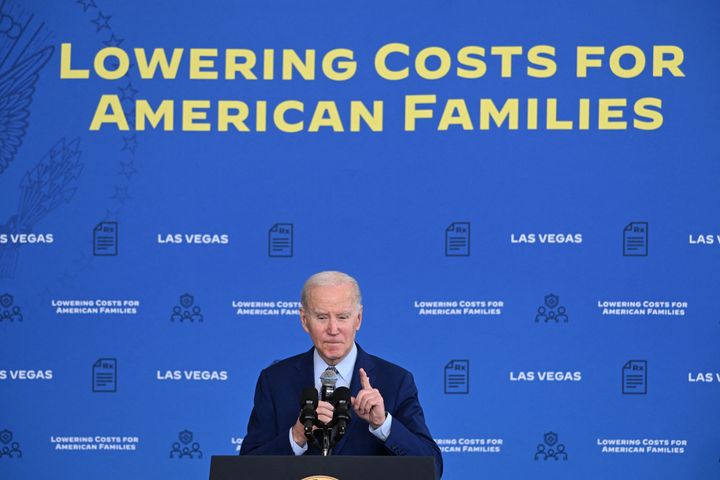
This article is part of HuffPost’s biweekly politics newsletter. Click here to subscribe.
If you want to understand why the Biden administration gets so little credit for its accomplishments ― and why, perhaps, it deserves to get a little more ― pay attention to a little-noticed policy announcement from last Friday.
The announcement was a list of 43 prescription drugs that are covered by Medicare and whose prices have risen faster than the rate of inflation. The list included relatively well-known drugs like Humira, which treats a variety of inflammatory conditions, plus some more obscure medications like Leukine, which helps cancer patients undergoing chemotherapy stave off infection.
Until recently, such price hikes would have simply meant higher costs for the Medicare program ― and for individual seniors paying out of pocket. Or, to put it more bluntly, American taxpayers as well as American consumers were at the complete mercy of the drug industry’s pricing.
But that’s not how things work anymore, thanks to the Inflation Reduction Act ― you know, the law that President Joe Biden and the Democratic Congress spent more than a year debating before finally enacting it in August 2022 and that almost everybody seems to have forgotten about since.
A big focus of the IRA is lowering prescription drug costs, and one way it does that is by penalizing drug companies that hike prices faster than the rate of inflation. The 43 drugs on last week’s list all met that criterion. Because of that, manufacturers will have to give some money back to the federal government, effectively helping to fund Medicare costs.
The IRA will also have a more direct effect on seniors. For each drug on the list, the federal government will reduce the “coinsurance” that individual seniors owe when they pay for the drugs, with savings that vary from $1 to $449 per dose, according to the administration’s calculations.
Now that may not sound like a lot of money to some of you ― and in some cases, certainly, it won’t be. I imagine that’s one reason the news isn’t getting more attention. Another is that these penalties apply to a fairly narrow class of drugs for a relatively small group of Medicare beneficiaries.
Then there’s the fact that the benefit is so darned hard to explain. You’ll notice that it took me several paragraphs and ― full disclosure ― I glossed over a whole bunch of details, like the fact that the 43 drugs all fall under Medicare’s Part B, which covers outpatient care. (These are mainly drugs delivered by infusion or injection rather than pills purchased at a pharmacy.)
With benefits like this, is it any wonder so few people realize they exist?
But the effects of the inflation penalties and reduced coinsurance will expand over time, covering more drugs, including the ones seniors get at the pharmacy. In addition, economists predict that drug companies in the future will be less likely to raise prices faster than inflation, lest they incur those penalties.
And that is just one of the new law’s provisions that will reduce the cost of prescription drugs.
There’s a cap on insulin prices and the widely publicized ability to negotiate prices directly with manufacturers, plus an overall limit on out-of-pocket drug spending. For some seniors, that will mean “big, tangible savings” reaching into the thousands of dollars, according to Tricia Neuman, senior vice president of KFF, the nonpartisan health care research organization. Neuman added that she’s surprised how much the feature has “flown under the radar.”
And, of course, the health care provisions represent just one way the IRA will affect everyday Americans. The real heart of the legislation is its provisions to promote use of clean energy, especially via products and resources developed here in the U.S.
My HuffPost colleague Alexander Kaufman wrote about this back in January, in an article focusing on the construction in Georgia of North America’s largest solar manufacturing plant. I’ve also seen this personally, from my home in Michigan, where it seems that not a week goes by without news of some auto industry company opening or retooling plants to produce electric vehicles and their component parts.
Not that everybody is happy about these developments. Every provision of the IRA has its critics, including conservatives who say that regulating prices (on prescription drugs) will discourage investment in research and dispute that climate change is even a threat worth addressing (via clean energy projects).
But there’s also a perceptible ambivalence even among people more sympathetic to the legislation’s goals, which undoubtedly has something to do with what all of these reforms won’t do. Climate change isn’t going away because of the green investments, and drugs are still going to cost more in the U.S. than they do in any other country.
There’s a reason for that. Both sets of provisions were the subject of compromises that their champions made in order to secure passage in a closely divided Congress.
But however incremental, however obscure or difficult to explain, these sorts of changes are what progress actually looks like in American politics. They’re going to make a tangible difference to a lot of people. It’s just a question of who is paying attention.
